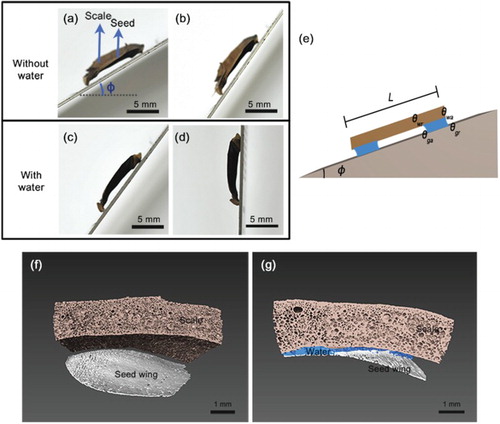Figures & data
Figure 1. Pine seed morphology and dispersal from the pine cone into the air. (a) A pine seed matures in a pine cone. (b) The pine seed consists of the seed and seed wing. (c,d) Schematics showing how pine cone scales respond to dry and rainy weather; the figures were generated using the 3ds Max software (Autodesk Inc., USA). (c) On a dry and sunny day, cone scales open and disperse pine seed. (d) In contrast, on a humid and rainy day, the cone folds its scales and prevents seed release.

Figure 2. Adhesion between pine seeds and pine cone scales. (a–d) The angle (φ) of the pine seed on the scale was gradually increased to test its adhesion with and without water. (a) A dry seed is laid on the pine cone scale and the angle of slide (φ) is gradually elevated. (b) A dry seed is started to slip as the slide angle increases over φs = 56.9°. (c,d) In contrast, a wet seed firmly adheres to the scale. Even at φ = 90°, the pine seed is not detached from the pine cone scale. (e) The notion of contact angle hysteresis explains the observed adhesion of pine seed to the glass with 2 separated water films observed in experiment. Here, we assume that the gravity creates advancing and receding angles θwa > θwr at the pine seed–water interface, and θga > θgr at the water–glass interface, located at specified positions. The contact angles for the second water film are assumed to be the same as those for the first water film. We denote the length of the pine seed to be L. (f) There is a gap between the dry scale and the seed wing. (g) When the gap is filled with water, the attractive force of water makes the seed wing attach to the scale.

Table 1. Experiment parameter for surface tension estimation.
Figure 3. Water evaporation from pine seed. (a) A water droplet falls down onto the surface of a pine seed wing. (b) The amount of water evaporation increases proportionally with time. (c) Symbol of ‘1st’ and ‘2nd’ and ‘CA’ indicate first evaporation experiment, second evaporation experiment and contact angle, respectively. The evaporation velocity and the contact angle of the pine seed wing are maintained even after three experiments; in contrast, the evaporation velocity and the contact angle of the maple seed rapidly decrease from the second experiment. Error bars indicate standard deviation (n = 5). (e) Wing tomogram shows that air spaces are maintained during water immersion.

Figure 4. Pine cone morphological changes in response to heat. (a) Pine seeds were maintained in the seed racks of pine cone that were placed between bract scale and scale. (b–e) Changes in seed rack morphology were observed using X-ray tomography. (b,d) The epiphysis of the cone scale is closed under normal conditions. (c,e) However, the gap in epiphysis of the cone scale is wide open following heating. (f,g) Cross-sectional images show that morphological changes of gap in the epiphysis of the cone scale response to heating: heating changes the epiphysis from a closed round circle to a splay shape.

